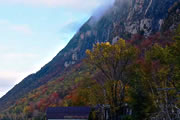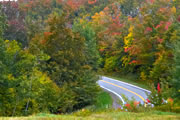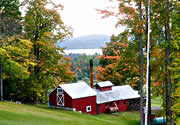Tips for taking Foliage Pictures with a Digital Camera
by Tim Palmer-Benson
 Digital
cameras do not have the dynamic range of film or its full spectrum
of color. But, they come pretty darnn close and they
are becoming better every year. Their market share continues
to grow. Do you know anyone these days that does not have a digital
camera? For most people, the technology has progressed sufficiently
that the results are completely acceptable to them.
Digital
cameras do not have the dynamic range of film or its full spectrum
of color. But, they come pretty darnn close and they
are becoming better every year. Their market share continues
to grow. Do you know anyone these days that does not have a digital
camera? For most people, the technology has progressed sufficiently
that the results are completely acceptable to them.
Successful digital photography requires that you pay special attention to the light and especially for foliage colors. Don't put your camera in a position where it has to translate a huge spectrum of color. Look for situations where it can peform at its best, such as a close up of some leaves. If you are someone who has experience with technology you will know how important it is to have things perform at their best. For example you wouldn't use a dial up connection if you could use broadband from O2, so why would you take pictures in an unsuitable place? Avoid harsh lighting situations. Here is a little check list of things you can do to ensure that get the best from your camera
- Remember to set the white balance for each shoot. The automatic presets of cloud, sunlight, indoor light (tungsten and flourescent) usually work well, but a manually set white balance is always better.This means learning the manual settings on your camera. It is not that difficult if you just spend a few moments reading the pertinent parts of the manual.
- Avoid taking pictures in the middle of the day under a bright sun. Take your pictures in the morning and afternoon. Watch for shadows and use your flash to fill in subjects such as faces and close objects. Be aware of special conditions and light. A light rain followed by sunlight can produce stunning results.
- Don't try to photograph wide panoramic landscapes unless you have the right equipment..such as zoom lenses, filters and yes, a tripod.
- When you find a good subject, whether it is a family photo or a group of trees, take at least four of five pictures at different angles and with slightly different exposure if possible. With digital cameras you don't have to worry about the cost of film and lab processing!
- Use a tripod - whenever possible use it! Believe me, you will notice the difference and be pleased by the results!
- Taking a long distance shot with a 200mm zoom lens can yield some surprising results, but remember that you must use a tripod for such pictures and a remote shutter release cable.
- Get the largest storage disk you can afford and set you camera to use its best quality setting. Be aware that the JPEG format used by many cameras is known as "lossey." This means that every time you open a .jpeg picture in your photo editing software and then save it again, you will lose some quality.
- Camera Raw: This is choice that you will find on better quality digital cameras. Camera Raw is the choice of professionals. It enables you to take a picture without any compression. Of course, it uses a lot of disk space, but if you want to achieve the best quality possible, it's the way to go. You will need Adobe Photoshop, Adobe Lightroom, or Apple's Aperture to process your pictures.
- Make back up copies of all your photos before editing them. Always keep a copy of an original that is untouched by any editing software. If you have Mac OS X you can use Iphoto to archive your pictures.
That's it for now. I'll be adding to this tip list from time to time and if you have some tips, why not send them to us or leave them on the photography forum.




